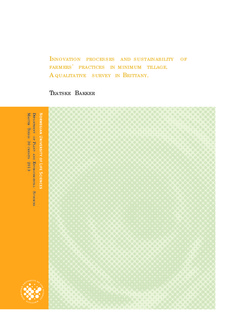| dc.contributor.author | Bakker, Teatske | |
| dc.date.accessioned | 2013-10-22T12:23:19Z | |
| dc.date.available | 2013-10-22T12:23:19Z | |
| dc.date.copyright | 2013 | |
| dc.date.issued | 2013-10-22 | |
| dc.identifier.uri | http://hdl.handle.net/11250/189655 | |
| dc.description | Introduction
Context and background, literature study
Material and methods
Results
Discussion and limits
Conclusion | no_NO |
| dc.description.abstract | This study aims answering the demands of the Regional Chambers of Agriculture and the SUSTAIN project: review farmers' practices in minimum tillage related to basic sustainability indicators, and highlight the innovation proces behind changes of practices in Brittany, in order to reveal farmers' expectations towards advisory services.The study was based on 29 qualitative interviews with farmers.
1) First, the description of cropping practices allowed to build a typology of crop management sequences for winter wheat and maize, which were linked to modifications in cropping systems (on cover crops management and rotations), resulting in three agronomic coherence classes. Farmers' caracteristics in each class were described. A difference appeared between farmers using deep tillage and the others, whereas the systemic approach of farmers with superficial tillage and no-tillage were rather similar. The type of farming system and the pedoclimatic conditions did not influence the classification, whereas socio-economic differences appeared, as well as evolutions in the perception of soils.
2) Focus was then put on sociological aspects by means of open-ended questions about motivations, information sources and and perception of other stakeholders of the innovation. Farmers enter a learning dynamic which bring them to reconsider their conception of soils and to adapt general principles of minimum tillage to their own specific context. The key point for accompanying innovation in tillage practices is to put farmers and their knowledge in the center of the interactions with other stakeholders, namely advisors. Considering complex cropping systems requires a joint effort from farmers and advisors to make the whole cropping system evolve.
In conclusion, the diversity of crop management sequences and modifications of the cropping system reflect different stages of the learning process. However, farmers are pragmatic and are not necessarily motivated to transform their systems all the way to no-tillage due to agronomic, economic and social brakes. Group dynamics appear suitable, as they allow farmer to exchange experiences. Multiplying the approaches (group meetings, personnal advice, conferences and demonstrations) and perspectives appears relevant to reach the targetted audience | no_NO |
| dc.language.iso | eng | no_NO |
| dc.publisher | Norwegian University of Life Sciences, Ås | |
| dc.relation.haspart | Summary in French of the report ("condensé de mémoire") | no_NO |
| dc.subject | innovation | no_NO |
| dc.subject | sustainability | no_NO |
| dc.subject | minimum tillage | no_NO |
| dc.subject | sociology | no_NO |
| dc.title | Innovation processes and sustainability of farmers' practices in minimum tillage. A qualitative survey in Brittany. | no_NO |
| dc.title.alternative | Processus d'inovation et durabilité des pratiques des agriculteurs en non labour. Une étude qualitative en Bretagne | no_NO |
| dc.type | Master thesis | no_NO |
| dc.subject.nsi | VDP::Agriculture and fishery disciplines: 900::Agriculture disciplines: 910::Plant breeding, horticulture, plant protection, plant pathology: 911 | no_NO |
| dc.subject.nsi | VDP::Social science: 200::Sociology: 220 | no_NO |
| dc.source.pagenumber | 92 | no_NO |
| dc.relation.project | Snowman network: Sustain project. | no_NO |
